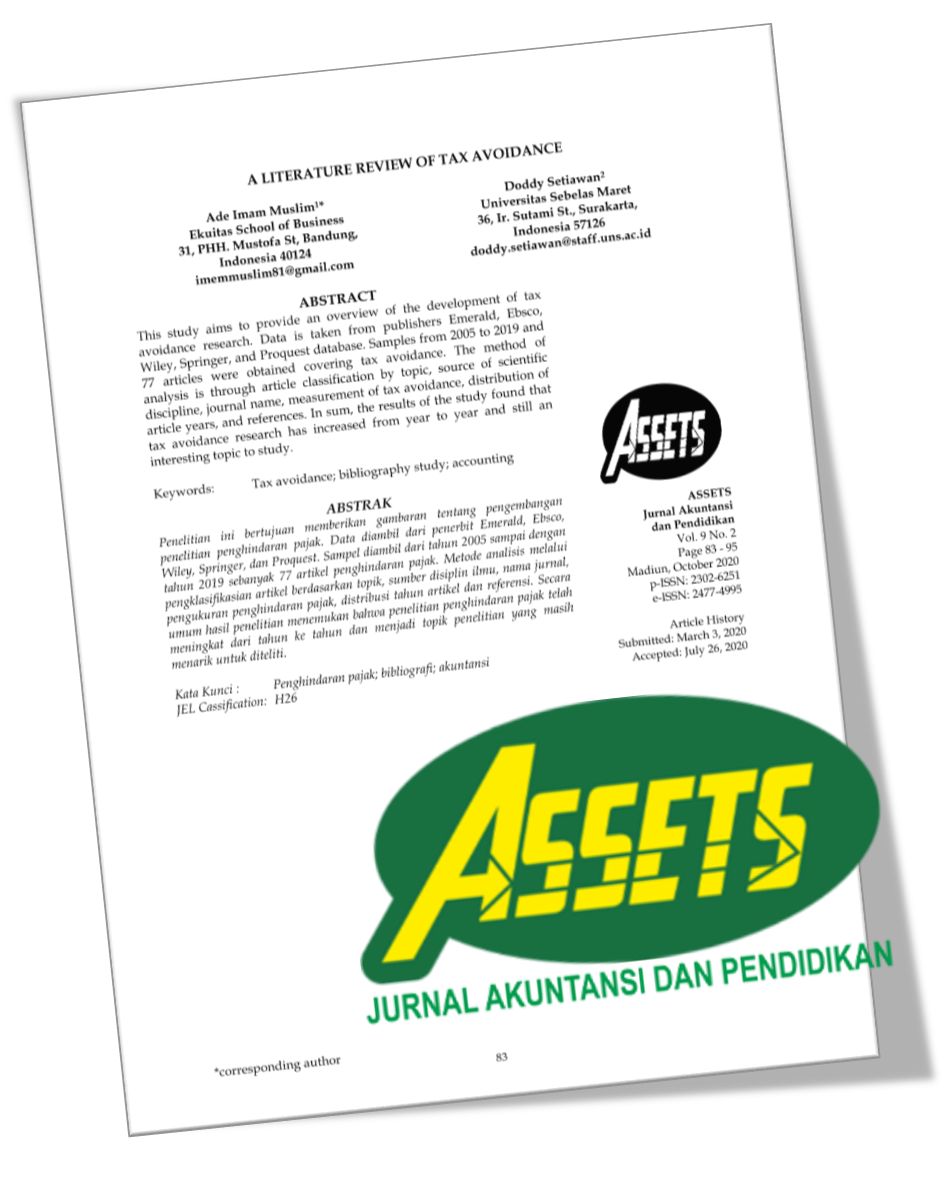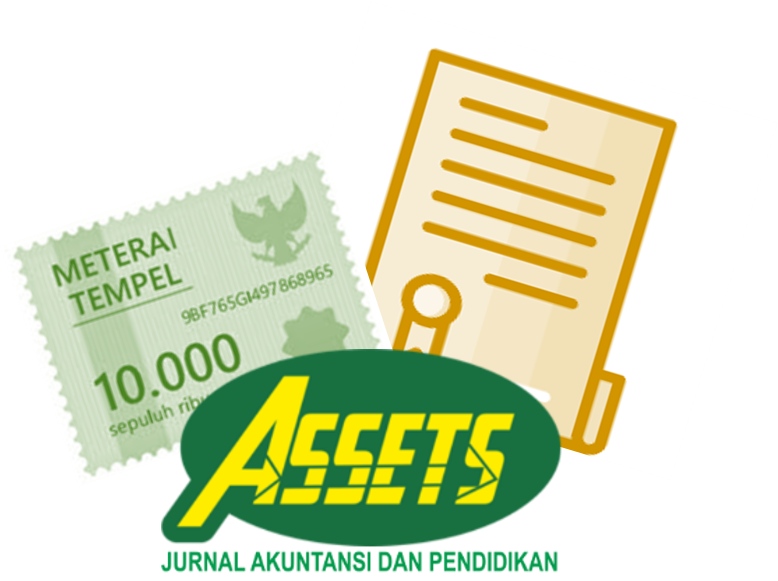EMPIRICAL EVIDENCE OF FINANCIAL DISTRESS IN INDONESIA
DOI:
https://doi.org/10.25273/jap.v10i2.8982Keywords:
Financial accounting, Financial distress, External factor, Internal factor, Literature review, Akuntansi keuangan, Kesulitan keuangan, Faktor eksternal, Faktor internal, Tinjauan literaturAbstract
ABSTRACT
This study aims to give empirical evidence on the development of research on financial distress in Indonesia. We identified articles with a cause-effect relationship where financial distress was used as the dependent variable. This study analyzed twenty-eight articles about financial distress, obtained from eighteen nationally accredited journals indexed under Sinta 2. We classified articles based on the research variables used, then analyzed them by using the charting field method. This study found that internal factors such as financial condition and corporate governance are used more often than external factors such as inflation, exchange rate, and Gross Domestic Product (GDP) in research about financial distress in Indonesia. Moreover, some variables gave inconsistent results and should be studied further to find such inconsistencies.
ABSTRAK
Penelitian ini bertujuan untuk memberikan bukti empiris tentang studi perkembangan financial distress di Indonesia. Kami mengidentifikasi artikel yang memiliki hubungan sebab akibat dimana financial distress ditempatkan sebagai variabel dependen. Penelitian ini menganalisis dua puluh delapan artikel tentang financial distress yang berasal dari delapan belas jurnal nasional terakreditasi dan terindeks Sinta 2. Kami mengklasifikasikan artikel berdasarkan variabel penelitian yang digunakan, kemudian melakukan pendekatan pemetaan (charting field). Studi ini menemukan faktor internal seperti kondisi keuangan dan tata kelola perusahaan lebih sering digunakan dibandingkan dengan faktor eksternal seperti inflasi, nilai tukar dan produk domestic bruto (PDB) dalam penelitian financial distress. Selain itu, terdapat beberapa variabel yang menunjukkan ketidakkonsistenan terhadap financial distress. Sehingga, perlu dilakukan pengkajian mendalam untuk mengetahui penyebab ketidakkonsistennya variabel-variabel tersebut.
Downloads
References
Agostini, M. (2018). Corporate Financial Distress: A Roadmap of the Academic Literature Concerning its Definition and Tools of Evaluation. Corporate Financial Distress, 5-47. http://doi.org/10.1007/978-3-319-78500-4_2
Almilia, L. S., and Kristijadi. (2003). Analisis Rasio Keuangan untuk Memprediksi Kondisi Financial Distress Perusahaan Manufaktur yang Terdaftar di Bursa Efek Jakarta. Jurnal Akuntansi dan Auditing Indonesia, 7(2), 183-210. https://journal.uii.ac.id/JAAI/article/view/846/765
Altman, Edward I. (1968). Financial Ratios, Discriminant Analysis and the Prediction of Corporate Bankruptcy. Journal of Finance, 23(4), 589-609. https://doi.org/10.2307/2978933
Antikasari, T. W., and Djuminah. (2017). Memprediksi Financial Distress dengan Binary Logit Regression Perusahaan Telekomunikasi. Jurnal Keuangan dan Perbankan, 21(2), 265–275. http://dx.doi.org/10.26905/jkdp.v21i2.654
Bae, J. K. (2012). Predicting Financial Distress of the South Korean Manufacturing Industries. Expert Systems with Applications, 39(10), 9159-9165. https://doi.org/10.1016/j.eswa.2012.02.058
Beaver, W. H. (1966). Financial Ratios as Predictors of Failure. Journal of Accounting Research, 4(3), 71-111. https://doi.org/10.2307/2490171
Cahyani, D. M., and Diantini, N. N. A. (2016). Peranan Good Corporate Governance dalam Memprediksi Financial Distress. Matrik: Jurnal Manajemen, Strategi Bisnis dan Kewirausahaan, 10(2), 144-155. http://dx.doi.org/10.24843/MATRIK:JMBK.2016.v10.i02.p05
Dianova, A., and Nahumury, J. (2019). Investigating the Effect of Liquidity, Leverage, Sales Growth, and Good Corporate Governance on Financial Distress. Journal of Accounting and Strategic Finance, 2(2), 143-156. https://doi.org/10.33005/jasf.v2i2.49
Dillak, V. J., and Fitri, Z. H. (2019). Identifying Financial Distress Firms: A Case Study on Property and Real Estate Companies Listed In Indonesian Stock Exchange. Jurnal Manajemen Indonesia, 19(3), 292-297. https://doi.org/10.25124/jmi.v19i3.2532
Ernawati, D., and Aryani, Y. A. (2019). Empirical Evidence of IFRS Studies in Indonesia. Jurnal Akuntansi dan Auditing Indonesia, 23(2), 65-77. https://doi.org/10.20885/jaai.vol23.iss2.art1
Fahlevi, E. D., and Mukhibad, H. (2018). Use of Financial Ratios and Good Corporate Governance to Predict Financial Distress. Jurnal Reviu Akuntansi dan Keuangan, 8(2), 147–158. https://doi.org/10.22219/jrak.v8i
Finishtya, F. C. (2019). The Role of Cash Flow of Operational, Profitability, and Financial Leverage in Predicting Financial Distress on Manufacturing Company in Indonesia. Journal of Applied Management, 17(1), 110-117. http://dx.doi.org/10.21776/ub.jam.2019.017.01.12
Gunawan, A. W., Assagaf, A., Sayidah, N., and Mulyaningtyas, A. (2019). Financial Distress di BUMN Indonesia dan Faktor-Faktor yang Mempengaruhi. Ekuitas: Jurnal Ekonomi dan Keuangan, 3(2), 226-243. http://dx.doi.org/10.24034/j25485024.y2019.v3.i2.4135
Hapsari, E. I. (2012). Kekuatan Rasio Keuangan dalam Memprediksi Kondisi Financial Distress Perusahaan Manufaktur di BEI. Jurnal Dinamika Manajemen, 3(2), 101-109. http://dx.doi.org/10.15294/jdm.v3i2.2438
Heniwati, E., and Essen, E. (2020). Which Retail Firm Characteristics Impact on Financial Distress?. Jurnal Akuntansi dan Keuangan, 22(1), 40-46. http://dx.doi.org/10.9744/jak.22.1.40-46
Herawati, N., and Bandi, B. (2017). Dua Puluh Tahun Riset Perpajakan dalam Akuntansi : Suatu Studi Bibliografi. Jurnal Akuntansi dan Keuangan, 19(2), 102–121. https://doi.org/10.9744/jak.19.2.102-121
Hesford, J. W., Lee, S. H., Stede, W. A. V., and Young, S. M. (2007). Management Accounting : A Bibliographic Study. In C. S. Chapman, A. G. Hopwood, & M. D. Shields (Eds.), Handbook of Management Accounting Research, (1st ed., pp. 3–26). London. https://doi.org/10.1016/S1751-3243(06)01001-7
Hilaliya, T., and Margaretha, F. (2017). Peran Corporate Governance dalam Menurunkan Kebangkrutan pada Perusahaan di Indonesia. Jurnal Akuntansi, 21(03), 391-410. http://dx.doi.org/10.24912/ja.v21i3.267
Holmes, G. M., Kaufman, B. G., and Pink, G. H. (2017). Predicting Financial Distress and Closure in Rural Hospitals. J Rural Health, 33, 239–249. http://doi.org/10.1111/jrh.12187
Ibrahim, R. (2019). Corporate Governance Effect on Financial Distress: Evidence from Indonesian Public Listed Companies. Journal of Economics, Business, and Accountancy Ventura, 21(3), 415-422. http://dx.doi.org/10.14414/jebav.v21i3.1626
Juniarti. (2013). Good Corporate Governance and Predicting Financial Distress Using Logistic and Probit Regression Model. Jurnal Akuntansi dan Keuangan, 15(1), 43-50. http://dx.doi.org/10.9744/jak.15.1.43-50
Kwee, H. (2020). Belasan Emiten Berisiko Delisting, Bagaimana Nasib Investor? Diunduh pada 23 Februari 2021, dari https://market.bisnis.com/read/20200713/192/1265000/belasan-emiten-berisiko-delisting-bagaimana-nasib-investor
Langabeer, J. R., Lalani, K. H., Champagne-Langabeer, T., and Helton, J. R. (2018). Predicting Financial Distress in Acute Care Hospitals. Hospital Topics, 96, 75–79. http://doi.org/10.1080/00185868.2018.1451262
Liou, D. K., and Smith, M. (2006). Macroeconomic Variables in the Identification of Financial Distress. SSRN Electronic Journal, 1-37. http://dx.doi.org/10.2139/ssrn.900284
Luft, J., and Shields, M. D. (2007). Mapping Management Accounting: Graphics and Guidelines for Theory-consistent Empirical Research. (C. S. Chapman, A. G. Hopwood, & M. D. Shields, Eds.), Handbook of Management Accounting Research. https://doi.org/10.1016/S1751-3243(06)01002-9
Mafiroh, A., and Triyono, T. (2016). Pengaruh Kinerja Keuangan dan Mekanisme Corporate Governance Terhadap Financial Distress (Studi Empiris pada Perusahaan Manufaktur yang Terdaftar di Bursa Efek Indonesia Periode 2011-2014). Riset Akuntansi dan Keuangan Indonesia, 1(1), 46-53. http://dx.doi.org/10.23917/reaksi.v1i1.1956
Munthe, K. (2014). Pendekatan Multinomial Logit Model dalam Memprediksi Kesulitan Keuangan pada Perusahaan yang telah Tercatat di Bursa Efek Indonesia. Jurnal Manajemen, 18(2), 177-190. http://dx.doi.org/10.24912/jm.v18i2
Muslim, A. I., and Setiawan, D. (2020). A Literature Review of Tax Avoidance. Jurnal Akuntansi dan Pendidikan 9(2), 83–95. http://doi.org/10.25273/jap.v9i2.6112
Nurfajrina, A., Siregar, H., and Saptono, I. T. (2016). Analisis Financial Distress pada Perusahaan Agribisnis di Bursa Efek Indonesia. Jurnal Keuangan dan Perbankan, 20(3), 448–457. http://dx.doi.org/10.26905/jkdp.v20i3.280
Ohlson, J. A. (1980). Financial Ratios and the Probabilistic Prediction of Bankruptcy. Journal of Accounting Research, 18(1), 109-131. https://doi.org/10.2307/2490395
Oktarina, D. (2017). Macroeconomic Indicators and Corporate Financial Ratios in Predicting Financial Distress. The Indonesian Accounting Review, 7(2), 219–230. http://dx.doi.org/10.14414/tiar.v7i2.1383
Oktarina, D. (2018). The Effect of Disclosure of Sustainability Report on Financial Distress with Company Performance as Intervening Variables. Journal of Accounting and Strategic Finance, 1(02), 109-121. https://doi.org/10.33005/jasf.v1i02.29
Pham, T., Talavera, O., Wood, G., and Yin, S. (2021). Quality of Working Environment and Corporate Financial Distress. Finance Research Letters, 102449. https://doi.org/10.1016/j.frl.2021.102449
Pujiastuti, T., and Yuharningsih. (2014). Anteseden Probabilitas Financial Distress pada Perusahaan Manufaktur di Indonesia. Jurnal Keuangan dan Perbankan, 18(1), 1–13. http://dx.doi.org/10.26905/jkdp.v18i1.767
Putri, V. A., and Siswanto, E. (2019). Pengaruh Penerapan Corporate Governance Terhadap Tingkat Financial Distress (Studi pada Perusahaan Sektor Pertambangan yang Terdaftar di Bursa Efek Indonesia Periode 2013-2017). Jurnal Manajemen Indonesia, 19(3), 277-291. https://doi.org/10.25124/jmi.v19i3.2415
Rahmawati, E., and Herlambang, P. (2018). Pengaruh Efektifitas Komite Audit Terhadap Financial Distress. Jurnal Reviu Akuntansi dan Keuangan, 8(1), 53-68. http://dx.doi.org/10.22219/jrak.v8i1.26
Ross, S. A., and Westerfield. (2005). Corporate Finance. McGraw-Hill International Edition, 53(9), 1689–1699.
Samuel, J., Enumah, M. D., David, C., and Chang. (2021). Predictors of Financial Distress Among Private U.S. Hospitals. Journal of Surgical Research, 267, 251-259. https://doi.org/10.1016/j.jss.2021.05.025
Santosa, D. F., Anggraeni, L., and Pranowo, K. (2020). Determinan Financial Distress Perusahaan Subsektor Ritel di Bursa Efek Indonesia. Jurnal Aplikasi Manajemen dan Bisnis, 6(1), 128-141. http://dx.doi.org/10.17358/jabm.6.1.128
Setyawati, I., and Amalia, R. (2018). The Role of Current Ratio, Operating Cash Flow and Inflation Rate in Predicting Financial Distress: Indonesia Stock Exchange. Jurnal Dinamika Manajemen, 9(2), 140-148. http://dx.doi.org/10.15294/jdm.v9i2.14195
Sumani. (2019). Prediksi Financial Distress: Rasio Keuangan dan Sensitivitas Makroekonomi Perusahaan Sektor Primer. Ekuitas: Jurnal Ekonomi dan Keuangan, 3(3), 285-305. http://dx.doi.org/10.24034/j25485024.y2019.v3.i2.4153
Sun, J., Li, H., Huang, Q. H., and He, K. Y. (2013). Predicting Financial Distress and Corporate Failure: A Review from the State-of-the-Art Definitions, Modeling, Sampling, and Featuring Approaches. Knowledge-Based Systems, 57(1), 41–56. http://doi.org/10.1016/j.knosys.2013.12.006
Suprianto, E., and Setiawan, D. (2017). Manajemen Laba di Indonesia : Studi Sebuah Bibliografi. Jurnal Keuangan dan Perbankan 21(040), 287–301. http://dx.doi.org/10.26905/jkdp.v21i2.1314
Utami, I. W., and Kartika, T. P. D. (2019). Determinants of Financial Distress in Property and Real Estate Companies. The Indonesian Accounting Review, 9(1), 109-120. http://dx.doi.org/10.14414/tiar.v9i1.1705
Veronica, M. S., Ida, I., and Winata, V. T. (2020). Using Cash Flow Ratios to Establish a Manufacturing Bankruptcy Prediction Model. Jurnal Manajemen Indonesia, 20(2), 114-121. http://dx.doi.org/10.25124/jmi.v20i2.3198
Vestari, M., and Farida, D. N. (2013). Analisis Rasio-Rasio dan Ukuran Keuangan, Prediksi Financial Distress, dan Reaksi Investor. Akrual: Jurnal Akuntansi, 5(1), 26-44. http://dx.doi.org/10.26740/jaj.v5n1.p26-44
Villas, M. V., Macedo-Soares, T. D. L. V. A. D., and Russo, G. M. (2008). Bibliographical Research Method for Business Administration Studies: A Model-Based on Scientific Journal Ranking. Brazilian Administration Review, 5(2), 139–159. https://doi.org/10.1590/S1807-76922008000200005
Vinh, V. X. (2015). Using Accounting Ratios in Predicting Financial Distress: An Empirical Investigation in the Vietnam Stock Market. Journal of Economics and Development, 17(1), 41-49. http://dx.doi.org/10.33301/2015.17.01.03
Wardhani, R. (2007). Mekanisme Corporate Governance dalam Perusahaan yang Mengalami Permasalahan Keuangan (Corporate Governance Mechanism in Company Financial Distress). Jurnal Akuntansi Dan Keuangan Indonesia, 4(1), 95–114.
Widhiadnyana, I. K., and Ratnadi, N. M. D. (2019). The Impact of Managerial Ownership, Institutional Ownership, Proportion of Independent Commissioner, and Intellectual Capital on Financial Distress. Journal of Economics, Business, and Accountancy Ventura, 21(3), 351-360. http://dx.doi.org/10.14414/jebav.v21i3.1233
Wruck, K. H. (1990). Financial Distress, Reorganization, and Organizational Efficiency. Journal of Financial Economics, 27(2), 419-444. https://doi.org/10.1016/0304-405X(90)90063-6
Zmijewski, M. E. (1984). Methodological Issues Related to the Estimation of Financial Distress Prediction Models. Journal of Accounting Research, 22, 59-82. https://doi.org/10.2307/2490859
Zoogah, D. B., and Rigg, J. S. (2014). Advancing Research Methodology in the African Context: Techniques, Methods, and Designs. Research Methodology in Strategy and Management, 8, 189–213
Downloads
Additional Files
Published
Issue
Section
License
Perjanjian Lisensi dan Hak Cipta
Saat mengirimkan naskah ke jurnal, penulis menyatakan bahwa:
- Mereka diberi wewenang oleh rekan penulisnya untuk masuk ke dalam perjanjian ini.
- Karya yang dimaksud belum pernah diterbitkan secara resmi sebelumnya, kecuali dalam bentuk abstrak atau sebagai bagian dari kuliah, resensi, tesis, atau overlay jurnal yang diterbitkan.
- Karya yang dimaksud tidak sedang dipertimbangkan untuk diterbitkan di tempat lain,
- Publikasi karya yang dimaksud telah disetujui oleh semua penulis dan oleh otoritas yang bertanggung jawab - secara tahu sama tahu atau eksplisit - dari lembaga tempat pekerjaan itu dilakukan.
- Mereka mengamankan hak untuk mereproduksi materi apa pun yang telah diterbitkan atau dilindungi hak cipta di tempat lain.
- Mereka menyetujui lisensi dan perjanjian hak cipta berikut.
Hak Cipta
Penulis yang menerbitkan dengan ASSETS: Jurnal Akuntansi dan Pendidikan menyetujui persyaratan berikut:
- Penulis mempertahankan hak cipta dan memberikan jurnal hak publikasi pertama dengan karya yang secara bersamaan dilisensikan di bawah Lisensi Atribusi Creative Commons (CC BY-SA 4.0) yang memungkinkan orang lain untuk berbagi karya dengan pengakuan kepenulisan karya dan publikasi awal di jurnal ini.
- Penulis dapat masuk ke dalam pengaturan kontrak tambahan yang terpisah untuk distribusi non-eksklusif dari versi jurnal yang diterbitkan dari karya tersebut (misalnya, mempostingnya ke repositori institusional atau menerbitkannya dalam sebuah buku), dengan pengakuan publikasi awalnya di jurnal ini.
- Penulis diizinkan dan didorong untuk memposting karya mereka secara daring (misalnya di repositori institusional atau di situs web mereka) sebelum dan selama proses pengiriman, karena dapat menghasilkan pertukaran yang produktif, serta kutipan lebih awal dan lebih besar dari karya yang diterbitkan.
License and Copyright Agreement
In submitting the manuscript to the journal, the authors certify that:
- Their co-authors authorize them to enter into these arrangements.
- The work described has not been formally published before, except as an abstract or part of a published lecture, review, thesis, or overlay journal.
- That it is not under consideration for publication elsewhere,
- That its publication has been approved by all the author(s) and by the responsible authorities – tacitly or explicitly – of the institutes where the work has been carried out.
- They secure the right to reproduce any material already published or copyrighted elsewhere.
- They agree to the following license and copyright agreement.
Copyright
Authors who publish with ASSETS: Jurnal Akuntansi dan Pendidikan agree to the following terms:
- Authors retain copyright and grant the journal right of first publication with the work simultaneously licensed under a Creative Commons Attribution License (CC BY-SA 4.0) that allows others to share the work with an acknowledgment of the work's authorship and initial publication in this journal.
- Authors can enter into separate, additional contractual arrangements for the non-exclusive distribution of the journal's published version of the work (e.g., post it to an institutional repository or publish it in a book), with an acknowledgment of its initial publication in this journal.
- Authors are permitted and encouraged to post their work online (e.g., in institutional repositories or on their website) before and during submission, as it can lead to productive exchanges and earlier and more extraordinary citations of published work.

ASSETS: Jurnal Akuntansi dan Pendidikan is licensed under a Creative Commons Attribution-ShareAlike 4.0 International License.










